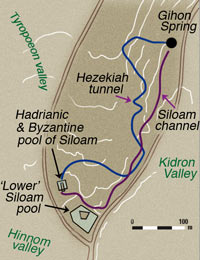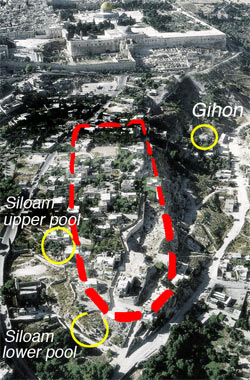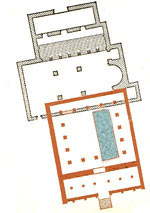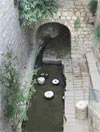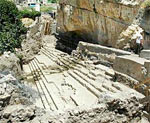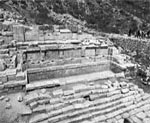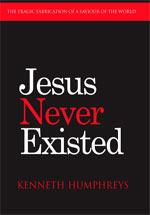Shalem's Sacred water
The Ophel Ridge (or Eastern Hill) running south from Temple Mount.
The ridge was first occupied during the Bronze Age. The attraction was the Gihon Spring – the only water source within a radius of five miles. The earliest settlement was named for the Syrian sun-god Shalem.
Jebusites (Canaanites) dug the first subterranean tunnel from the spring, making use of a natural sink hole in the hill above.
It is this so-called "Warren's Shaft" that defenders of the faith argue was used by the warriors of King David to take the city by stealth.
Fat chance.
The pools of Siloam remained outside of "David's" city.
Tunnel vision
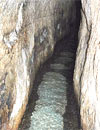
Hezekiah's tunnel – meanders for 1500 feet to terminate at the pool of Siloam. If Hezekiah ever built a pool himself it remains unknown.
Overflowing water fed a secondary pool (Birket el-Hamra, "the Red Pool").
Siloam: recycled "sacred space"
The Siloam water courses terminated in a "sacred" pool where the Emperor Hadrian built a temple, the Byzantines a church and the Muslims a mosque.
Unwittingly, in the year 333, the Pilgrim of Bordeaux described this Hadrianic nymphaeum:
"Also as you come out of Jerusalem to go up Mount Sion, on the left hand, below in the valley, beside the wall, is a pool which is called Siloe and has four porticoes; and there is another large pool outside it. This spring runs for six days and nights, but on the seventh day, which is the Sabbath, it does not run at all, either by day or by night."
In the 5th century, the Empress Eudocia replaced the Hadrianic shrine with a Christian basilica. By then the notion that "Jesus had performed a miracle here" was well established.
In the 9th century the Christian church was itself replaced by a mosque.
Siloam pool today
The "other large pool" described by the Pilgrim of Bordeaux was lost until recently. Less than 200 yards from the first, it was rediscovered in 2004. With poor maintenance, the pool had silted up during the Christian era and had eventually been buried.
The new pool was much larger than the first, about 225 feet long and perhaps as wide (much remains under a garden). Four sets of stone steps led into the water, allowing bathers to enter at its varying levels.
Siloam pool II
▲
Compare and contrast
▼
Hadrianic nymphaeum at Sagalassos, south-central Turkey.
Without embarrassment, today's apologists are quite happy to reassign the Jesus wizardry to this new (and much more impressive!) pool – which is either the largest Jewish ritual bath ever found – or a standard Roman nymphaeum!
Nymphaeum were common to Roman cities, particularly in the eastern provinces.
The impressive nymphaeum at Jerash.
In a later age, when their faith enjoyed the benevolent support and advocacy of the Roman state, the Christians were able to retro-fit a sacred landscape within the Palestinian littoral. It would of course match the pious dreamscape pre-figured in the gospel fable. A Jesus trail, a perambulations between sanctified venues, would, by the 6th century, give concrete form to a sacrificial journey already established in the Christian mind as both profane and holy. As it was, in the less favoured circumstances of the 2nd century, the evangelists of divine message and miracle prepared the ground with fancies of their own. Where Jesus venues were not entirely unstated – a vagueness which left plenty of scope for imaginative "placement" – they were shrewdly calculated to scupper the competition and expropriate the magic of earlier gods. The first target of the Christians was the parent faith that had given rise to their heresy – Judaism.
The pre-history of a "Jesus miracle at the pool of Siloam"
The Gihon spring rises within a cave at the foot of the Ophel hill. The spring's habit of gushing intermittently – the effect of a natural siphon – probably added to the awe and sacredness of a water source which could determine life or death in terrain at the edge of a desert. The gently flowing Gihon even gave its name to one of the four rivers of Eden, dreamed up by the author of Genesis. The runoff from the stream flowed down the Kidron valley and pooled at a low point where the Kidron met with the Tyropoeon and Hinnom valleys. It was this pooling of water at the convergence of three valleys which encouraged Canaanite settlement of the hill above. The spot would in time be known as Siloam (aka Siloah), perhaps derived from the Hebrew shalah meaning "sent" (that is, by God). Both the spring and the pool must have been revered as "holy" from the earliest times.
Hezekiah digs a tunnel If the Book of Kings is to be believed, in the early 7th century BC Hezekiah ordered the construction of a tunnel through the Ophel hill to protect the township's water supply (2 Kings 20.20). Apparently the Assyrians were threatening the city. The ancient Jebusite water channel – external to the original town – and a tunnel from the 7th century BC are real enough. Biblical enthusiasts trumpet the tunnelling achievement as if it proved some special attribute of the Jews. Though the tunnelling is impressive the technique of crews digging from either end was well-known in the ancient world. Hezekiah's diggers made many false turns and actually dug a tunnel 1500 feet long to cover a distance of 1000 feet. They tunnelled under 150 feet of rock at an average width of two feet. There is a similar, and more impressive, water tunnel on the Greek island of Samos, the Tunnel of Eupalinos. It passes under the 900 feet high Mount Castro and is 3400 feet in length.
Rain Dance At some point in Judaean pre-history a rain festival developed which associated the natural valley reservoir with a sanctuary on the hill above and sacrifices to the god Baal. Later, Israelite settlers adopted the ritual and they made it their own – the Feast of Tabernacles. Tellingly, when the author of 1 Kings describes the sanctification of the first temple, he refers not to the Hebrew month of Sukkot but to the Canaanite Ethanim:
In the Feast of Tabernacles priests carried water from the pool of Siloam to the temple precinct, where they sprinkled it on the altar of the burnt offering, paraded about with palm fronds and made an appeal to God for rain in the coming year. Siloam and Tabernacles stood at the heart of Judaism – and the author of John is determined that his hero will displace that creed entire. Among other things Jesus is the real "manna from heaven":
Negating Jewish magic The Jesus "miracle at the pool of Siloam" appears only in the gospel of John, although restoring a blind man's sight was a stock item on the miracle menu. At Bethesda a word from the godman was all that it required to affect a cure. But in the Siloam yarn the recipe for healing is far more elaborate. JC first rolls mud patties with his own spit (that's quite some spittle!) and places them on the blind man's eyes. Untypically, Jesus approaches the man, not vice versa.
It one sense, the "miracle" is a substitute for the trial of Jesus by the Jews found in the synoptic gospels. The unbelieving Jews question the miracle and the Pharisees are divided about it (it is, after all a sabbath day!) The parents of the erstwhile blind man "fear the Jews" (John 9.22) but know the truth. By gospel standards, there follows a lengthy debate between the healed man himself and the recalcitrant Jews.
The whole tale is pure theology, encapsulating the entire Christian revolution. The Siloam miracle story is a proxy for the 2nd century conflict between Jewish orthodoxy and the new Christian heresy.
Having Eyes to See Interestingly, blindness – a punishment from God – features in the disconcerting tale of David's capture of the fort of Jebu. The blind are "hated of David's soul". Nice.
"Good Shepherd Jesus" is also the "Door of the Sheep Pen"! Gospeller John continues with his theme of Jesus supplanting the whole of Judaism, with his yarn moving on to the Feast of the Dedication (Hanukkah) and with Jesus now both a "door" (to salvation) and a shepherd to the sheep. Accordingly, he locates his hero in Solomon's Porch, the towering entrance to the Temple described by Josephus (see below). Alarmingly, John has Jesus declare that all previous prophets and patriarchs have been "thieves and robbers":
Again, the flimsy topographical marker (the Temple porch) is not an historical reference but merely an anchor for another swipe at an obsolete Judaism. Jesus is the whole deal, in one convenient package. Acts uses the same device, having the Jews who witnessed Peter's healing miracle "run together unto them in the porch that is called Solomon's, greatly wondering" (Acts 3:11).
Sources:
'Save' a friend - e-mail this page Copyright © 2007
by Kenneth Humphreys.
|
||||||||||||||||||||||||||||||||||||||||||||||
